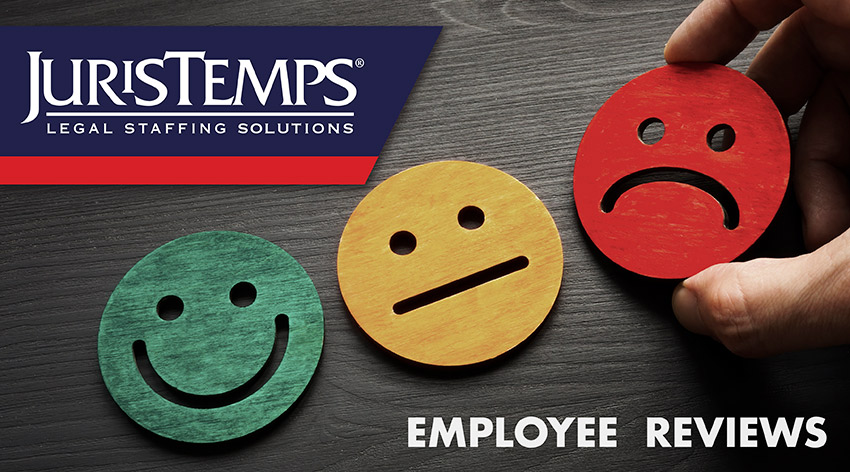July 1, 2022
6 Tips for Conducting a Successful Employee Review

Running an employee performance review is a complex process. Your best employees will likely take their own steps to make sure the review goes well, but there are measures employers can take on their end to bring about the most productive results.
A successful employee review should be a positive experience, even if some of the feedback is focused on points of missed expectations. There are ways to frame negative feedback so it inspires meaningful action, instead of bringing down morale. Of course, reviews are also a great opportunity to applaud their wins, learn about their professional ambitions, and make them feel like a valued member of your firm. More importantly, however, a successful review must be designed to improve employee performance in the future. Done correctly, an employee review can boost engagement, reduce turnover, and even tap undiscovered talent within your ranks. A poorly conducted review, on the other hand, has the potential to produce the opposite effect.
Here are six steps that will help you craft an effective and positive employee review experience.
1. Send out an agenda
Create the understanding that you value every employee’s contribution by preparing everything you need in advance. Suppose you treat the experience of performance reviews too casually by “winging it” on the day of the review. In that case, you risk sending the message that their performance isn’t impactful enough to warrant your close or careful attention. Send your employees an agenda for the performance review beforehand and give them the opportunity to add topics so they know their key concerns will be addressed. This small gesture shows that you take their progress in your company seriously, which will motivate them to show up in a professional and focused state of mind.
2. Provide a hard copy of their feedback
On the day of the review, you should come prepared with a printed version of all the points of feedback you plan to give your employee. Whether you’re making a point about attendance, giving feedback from a client, or comments from coworkers about the employee’s competencies, give them a hard copy record that includes everything you plan to address in the review. These situations can be anxiety-inducing for many people. You can make it a more productive experience by ensuring they’re not trying to commit every piece of feedback to memory.
3. Keep avenues open for conversation
Traditionally, employee reviews were one-sided, with managers simply informing employees of their past performance figures and nothing more. Today, more employers are seeing the value of using performance reviews to increase employee engagement and gather insight into what they think would help them grow and make even better use of their skills. For this reason, avoid using the entire review time to only give feedback. Plan to engage employees in an open conversation during their review, and give them the opportunity to voice their struggles, talk about goals, and even brag a little about the accomplishments they’re most proud of. Rather than making the review a one-way evaluation, focus on getting to the heart of what your employee needs to grow so you can align your goals for the future.
4. Be thoughtful with your language
If you have feedback that might be difficult to hear, always prepare how you’re going to articulate it beforehand. How you deliver feedback can strongly impact how it’s received, so it’s important to be thoughtful about how you phrase what needs to be said without walking on eggshells — or stomping on feelings. One of the best ways to avoid an uncomfortable conversation is to connect every point of negative feedback to a course for corrective action. This not only shows that you aren’t lingering on their failures but that you have faith they can make progress with the right steps and guidance.
5. Identify goals and next steps
By the time the conversation is over, you should both have a general idea of what areas the employee can improve on. You may have discovered some unexpected goals along the way, or you might be building off goals that were established earlier that you’re still working toward. Whatever basic objectives you’ve discussed during the review, don’t assume they’ll take that vague understanding with them once they leave the meeting. As the conversation wraps up, make sure you clearly articulate the new goals that are being set. Whether it’s a young associate who wants to be more confident in client meetings or a paralegal with ambitions of going to law school, make a definitive record of the next steps in the process.
6. Establish a follow-up plan
Never leave an employee review without establishing a framework of how you’ll be tracking their progress. Whatever measurement you’ve established for tracking their continued improvement, make it clear how and when you’ll follow up in the future. This lets them know that their progress is on your radar and will resurface as a topic in their next employee review.
Annual reviews used to be the norm, but these days it’s common to hold them at more regular intervals. With recurring monthly or quarterly reviews, you can lay out a clearly traceable path to improvement for every employee. Plus, they offer a valuable opportunity to get ahead of any sources of frustration that have the potential to drive away employees.
Find winning talent with JurisTemps
Looking for reliable talent? JurisTemps has been matching best-in-class talent with law firms and enterprise companies for more than 20 years. Contact us to learn more about JurisTemps Legal Staffing Solutions.


